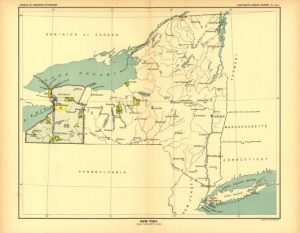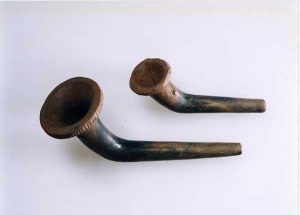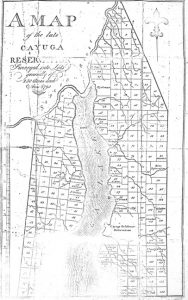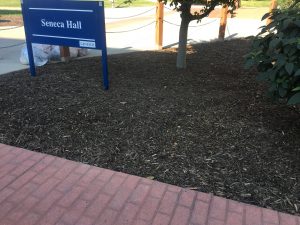The land upon which SUNY Geneseo now sits originally belonged to the Haudenosaunee people, particularly the Senecas, prior to European colonization.
In 1779, during the Revolutionary war, George Washington sent Generals Sullivan and Clinton on an “expedition…against the hostile Indian tribes of the north” (Norton, V). They used a “scorched-earth policy” meaning they entered native villages and burned all the homes and fields to the ground, which would force the natives to move off of the land that the colonists wanted to claim. Doty writes, “As a measure of future security to the settlements it fully accomplished its object; this attained, red men and white alike briefly quit the region; the former, save as a broken remnant, never to return” (Doty, 22) Many of the natives retreated and took refuge at a fort in the north.
The history of the Geneseo region is quiet for a few years, until Col. Jeremiah Wadsworth bought the land and sent his two younger relatives, James and William Wadsworth, to cultivate the land in 1790. They are considered the first settlers of the Geneseo area, and many buildings and streets around the town were given the Wadsworth name.
In 1797 the Wadsworths orchestrated the Treaty of Big Tree. This treaty was paramount to the European settlement of this area, because the treaty effectively robbed the Senecas of the rest of their land in New York State.
The myth of Geneseo then is that after 1797 and the Treaty of Big Tree, natives in the area just disappeared. I couldn’t find any last native name, and most of the books that I looked through shifted focus after this Treaty to the European settlements. Effectively, the story says that during the Revolutionary War Generals Sullivan and Clinton burned down all the native villages, the natives fled to Canada or Buffalo or Wisconsin, and any that remained were robbed of their land in the following decades through treaties with the state and federal governments, and European encroachments.
Sources:
Doty, Lockwood R. History of Livingston County, New York. W. J. Van Deusen, Publisher. 1905
NORTON, A TIFFANY. HISTORY OF SULLIVAN’S CAMPAIGN AGAINST THE IROQUOIS: Being a Full Account of That Epoch … (Classic Reprint). FORGOTTEN BOOKS, 2015.
Wadsworth, H. A. Two Hundred and Fifty Years of the Wadsworth Family in America Containing an Account of the Family Reunion, at Duxbury, Mass., September 13, 1882, and a Genealogical Register, Prepared Expressly for This Work. 1883.



